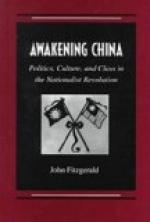Said the High Commissioner Tuan Fang, in an address to the Mission Boards at New York, February 2,1906:
“We take pleasure this evening in bearing testimony to the part taken by American missionaries in promoting the progress of the Chinese people. They have borne the light of Western civilisation into every nook and corner of the Empire. They have rendered inestimable service to China by the laborious task of translating into the Chinese language religious and scientific works of the West. They help us to bring happiness and comfort to the poor and the suffering by the establishment [Page 264] of hospitals and schools. The awakening of China which now seems to be at hand may be traced in no small measure to the hand of the missionary. For this service you will find China not ungrateful.”
Mission stations, now counted by hundreds, have generally high schools or colleges. Not only is the science taught in them up-to-date, but the conscientious manner in which they are conducted makes them an object-lesson to those officials who are charged with the supervision of government schools. To name only a few:
Here in Peking is a university of the American Methodist Episcopal Church which is not unworthy of the name it bears. At Tungchow, a suburb of the capital, is a noble college of the American Board (Congregationalist) which is in every point a worthy compeer. These cooeperate with each other and with a Union Medical College which under the London Mission has won the favour of the Empress Dowager.
The American Presbyterian Mission has a high school and a theological seminary, and cooeperates to a certain extent with the three societies above named. A quadrilateral union like this speaks volumes as to the spirit in which the work of Christian education is being carried forward. The Atlantic is bridged and two nations unite; denominational differences are forgotten in view of the mighty enterprise of converting an empire. In the economy of their teaching force they already experience the truth of the maxim “Union is Strength.”
In Shantung, at Weihien, there is a fine college in [Page 265] which English Baptists unite with American Presbyterians. The original plant of the latter was a college at Tengchow, which under Dr. Mateer afforded conclusive proof that an education deep and broad may be given through the medium of the Chinese language. In most of these schools the English language is now claiming a prominent place, not as the sole medium for instruction, but as a key to the world’s literature, and a preparation for intercourse with foreign nations.
At Shanghai, which takes the lead in education as in commerce, there is an admirable institution called St. John’s College which makes English the basis of instruction. Numberless other schools make it a leading branch of study to meet the wants of a centre of foreign trade.
One of the best known institutions of Shanghai is a Roman Catholic College at Siccawei, which preserves the traditions of Matteo Ricci, and his famous convert Paul Sue. In connection with it are an astronomical observatory and a weather bureau, which are much appreciated by foreigners in China, and ought to be better known throughout the Empire.




